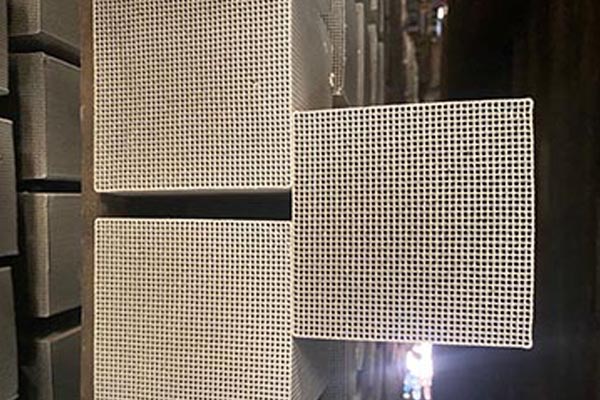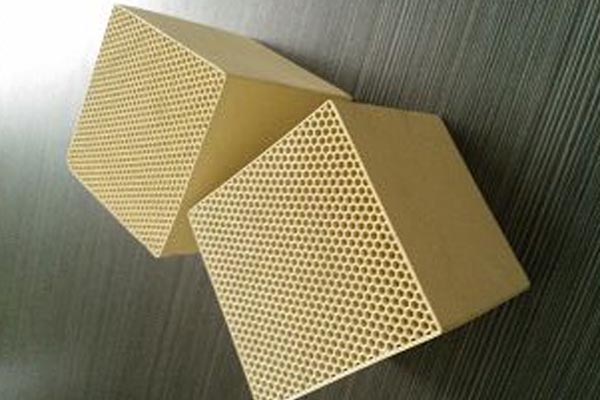
Honeycomb activated carbon Beijing Because the aluminum oxide tetrahedron of zeolite has a negative charge, and the skeleton hole contains cations, a strong electric field is formed around the cations. Therefore, the adsorption force of zeolite not only has a strong dispersion force, but also has a large electrostatic force. It is precisely because of this electrostatic relationship that zeolites have preferential selective adsorption on polar, unsaturated and polarizable molecules. It can strongly adsorb molecules containing polar groups such as hydroxyl ion, ammonium ion and other polarizable groups, especially water, which can form hydrogen bonds with aluminum silicon skeleton, so zeolite has strong water absorption. It can still adsorb even under low relative humidity and concentration, and its water absorption is higher than that of silica gel and activated alumina. The main material of honeycomb zeolite adsorbent is natural zeolite. The manufacturer of zeolite is composed of silica Inorganic microporous material composed of al_2o_3 and alkaline metal or alkaline earth metal, with inner pore volume accounting for 40-50% of the total volume and specific surface area of 100-500 m2/g, is characterized by high temperature resistance, non flammability, good thermal stability and hydrothermal stability. It is an efficient molecular sieve carrier with good adsorption performance, no secondary pollution, and can be regenerated at high temperature. Compared with honeycomb activated carbon, its performance is about 25% of its efficiency, However, it is widely used in the fields of adsorption, separation, catalysis and environment due to its high temperature resistance and difficult ignition. It is more suitable for the treatment of organic waste gas with large air volume and low concentration.

Honeycomb activated carbon major The holes and channels inside the zeolite crystal are uniform and fixed in size, and the diameter of the holes is generally 6~15A. Only molecules with smaller diameter can enter the cavity through the zeolite channel and be adsorbed, while large molecules cannot enter the cavity and be adsorbed. Zeolite is also called molecular sieve because of its selective adsorption performance. Honeycomb activated carbon Beijing However, silica gel, activated carbon and other adsorbents have no selective adsorption and screening performance due to their non uniformly fixed pore sizes and large changes. The main material of honeycomb zeolite adsorbent is natural zeolite. The manufacturer of zeolite is composed of silica Inorganic microporous material composed of al_2o_3 and alkaline metal or alkaline earth metal, with inner pore volume accounting for 40-50% of the total volume and specific surface area of 100-500 m2/g, is characterized by high temperature resistance, non flammability, good thermal stability and hydrothermal stability. It is an efficient molecular sieve carrier with good adsorption performance, no secondary pollution, and can be regenerated at high temperature. Compared with honeycomb activated carbon, its performance is about 25% of its efficiency, However, it is widely used in the fields of adsorption, separation, catalysis and environment due to its high temperature resistance and difficult ignition. It is more suitable for the treatment of organic waste gas with large air volume and low concentration.

With the continuous deepening of research, honeycomb zeolite molecular sieve has gradually moved from laboratory to industrial practical application. Due to its powerful performance, it can be integrated with the reactor, Beijing Honeycomb activated carbon In membrane catalytic reaction, the reaction is coupled with separation. At present, the application fields of zeolite membrane are pervaporation, gas separation and membrane reactor. It is the needs of human practical activities and the development of application fields that constantly promote the development of zeolite molecular sieves. From natural zeolite to synthetic zeolite, from low silica zeolite to high silica zeolite; From silicoaluminium molecular sieve to aluminophosphate molecular sieve; From super micropore to mesoporous material; Honeycomb activated carbon major The development from inorganic porous frameworks to MOFs, as well as the recent emergence of macroporous materials, has effectively improved the yield, reduced the synthesis cost and environmental pollution.

Honeycomb activated carbon major In the process of removing impurities in the liquid and gas phases, the porous structure of zeolite provides a large amount of specific surface area, which makes it very easy to absorb and collect impurities. Due to the mutual adsorption of molecules, a large number of molecules on the pore wall of zeolite can generate strong gravity, just like magnetic force, So as to achieve the purpose of attracting impurities in the medium to the aperture. The main material of honeycomb zeolite adsorbent is natural zeolite. The manufacturer of zeolite is composed of silica Inorganic microporous material composed of al_2o_3 and alkaline metal or alkaline earth metal, with inner pore volume accounting for 40-50% of the total volume and specific surface area of 100-500 m2/g, is characterized by high temperature resistance, non flammability, good thermal stability and hydrothermal stability. It is an efficient molecular sieve carrier with good adsorption performance, no secondary pollution, and can be regenerated at high temperature. Compared with honeycomb activated carbon, its performance is about 25% of its efficiency, Honeycomb activated carbon manufactor However, it is widely used in the fields of adsorption, separation, catalysis and environment due to its high temperature resistance and difficult ignition. It is more suitable for the treatment of organic waste gas with large air volume and low concentration.



